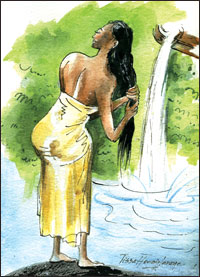Woman figure in wash technique
Tissa HEWAVITARANE
From Ajantha caves in India, in rocky mountains of Himalayas, rock
wall paintings in Dambulla and Sigiriya, (Sri Lanka) in ancient
cathedrals, Buddhist temple murals, stone carvings in Polonnaruwa and
Anuradhapura woman was prominently displayed.
The village damsel sporting local village attire (cloth and jackets)
carrying a pot of water tucked to her belly, woman bathing in the river
semi dressed, a tantalizing figure of a woman dancer on stage, a bevy of
beautiful girls on a cat walk draped and semi draped with their
wriggling bodies bring splendour visuals. Writers, poets, musicians,
painters, photographers and dancers perform and bring creativity to life
through a woman. Woman figure is a monument of art. The female form is
the one most used, published, drawn or painted. Stone age artists
depicted their woman folk as having huge buttocks.
|

A woman after a bath |
This was the way they actually were when man kind first stopped
crawling about and stood up, the powerful gluteal muscles were
responsible for holding up the body weight. Since then the human form
has changed and continues to alter. Modern women has evolved to own
narrow hips a deeper flatter tummy and generally quite pronounced
rounded breasts. Today she is no longer looks like a cave woman.
Each artist has his own pet methods in drawing the female figure in
water colour which seems to work best for him. There is no single 'best
way' to get going. Artists have to try several ways and techniques and
go with the methods that seem to accomplish their purpose.
Painting on dry paper using washes
Pure wash paintings on dry paper are seldom done any more. Washes are
large areas of colour applied evenly to the paper, producing flat colour
shapes. Usually several loaded brushes are required to cover the area.
Easiest to apply are washes that can be laid on from top to bottom.
Start on a slanted surface, and mix enough colour to cover the
surface. Use the largest brush possible and load it with mixture
applying it quickly in long even strokes.
Keeping the bottom of the wash very wet (leaves a ridge of colour
wetness there) apply the next brushful. Repeat the process until the
desired area is covered. Use the squeezed out brush or blotting paper to
absorb the excess from the bottom of the shape, or else it will bleed
back into the wash area as it dries producing an unwanted cloud or sun
burst.
Copying is an aid to successful drawing
Through out the ages almost all beginner artist start off by copying
illustrations, you shouldn't think of this as cheating. Copying valuable
because it teaches you how to look properly and how to draw accurately -
the basic of good art. A first class copy of a drawing requires great
ability. Drawing from life, in fact, is copying what is seen. The big
difference is all in the mind.
The degree of self confidence is different that's all. After
experience has been gained, copying is replaced by working from lite or
doing your own thing. As I suggested in earlier lesson (male figure in
wash) photographs can provide an alternative source to work.
Notice the illustration I have done 'a woman after a bath'. The woman
figure was drawn from life. First the basic structure was put down in
pencil.
The drawing has to be done quickly before her pose changes. Remember
always a water-colourist has to be fast doing a painting, especially out
doors.
While you are on site the wheather could change, before you finish
the painting. Observe the curve lines and the shading I have done on the
back, with wet clean brush strokes. Colour is dragged from the back in a
soft gradation reserving the hips of the spinal column.
The process is continued with a dark shade from the right side of the
thigh which defines the round shape of the back and showing the hip
prominently.
The colour of the skin on the body is shown with an burnt sienna
transparent layer of paint. While the paper is wet, the sienna tone is
added to the side of the body blends in easily and suggest the volume.
The back is painted with a light colour and the burnt sienna is
blended by successive brush strokes to the back. Very transparent
greenish yellow is added which mixes with the previous coats of colour.
The hair is painted with a mixture of lamb black and cobalt blue.
Dark tones are applied most of which were curved and ran the way
locks fell. When sketching and painting hair are that it reflects strong
lights and has several degrees of tone. Those go from dense black
through medium grey to white.
To put the final touches to contrast of the body of the figure, all
that has to be done is to paint a dark background in the way shadow
tones are perceived as having more volume due to the contrast, while the
clearer tones gain luminosity.
Finally doing a sketch or a colour wash of a woman figure the painter
must respond rapidly to any movement, however complicated it may be.
Do not hesitate to adapt the sketch to your interest, for at times
the model is not always the subject of artistic expression.
The only way to master each subject of artistic expression.
The only way to master each subject skilfully is through practice.
www.tissahewavitarane.com |



